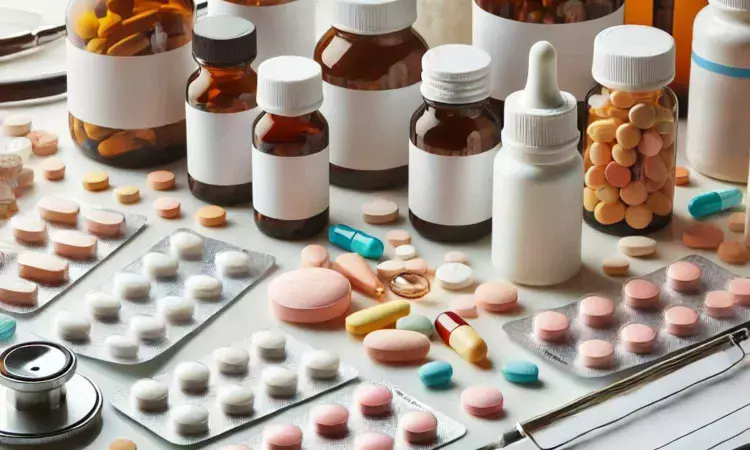- Home
- Medical news & Guidelines
- Anesthesiology
- Cardiology and CTVS
- Critical Care
- Dentistry
- Dermatology
- Diabetes and Endocrinology
- ENT
- Gastroenterology
- Medicine
- Nephrology
- Neurology
- Obstretics-Gynaecology
- Oncology
- Ophthalmology
- Orthopaedics
- Pediatrics-Neonatology
- Psychiatry
- Pulmonology
- Radiology
- Surgery
- Urology
- Laboratory Medicine
- Diet
- Nursing
- Paramedical
- Physiotherapy
- Health news
- Fact Check
- Bone Health Fact Check
- Brain Health Fact Check
- Cancer Related Fact Check
- Child Care Fact Check
- Dental and oral health fact check
- Diabetes and metabolic health fact check
- Diet and Nutrition Fact Check
- Eye and ENT Care Fact Check
- Fitness fact check
- Gut health fact check
- Heart health fact check
- Kidney health fact check
- Medical education fact check
- Men's health fact check
- Respiratory fact check
- Skin and hair care fact check
- Vaccine and Immunization fact check
- Women's health fact check
- AYUSH
- State News
- Andaman and Nicobar Islands
- Andhra Pradesh
- Arunachal Pradesh
- Assam
- Bihar
- Chandigarh
- Chattisgarh
- Dadra and Nagar Haveli
- Daman and Diu
- Delhi
- Goa
- Gujarat
- Haryana
- Himachal Pradesh
- Jammu & Kashmir
- Jharkhand
- Karnataka
- Kerala
- Ladakh
- Lakshadweep
- Madhya Pradesh
- Maharashtra
- Manipur
- Meghalaya
- Mizoram
- Nagaland
- Odisha
- Puducherry
- Punjab
- Rajasthan
- Sikkim
- Tamil Nadu
- Telangana
- Tripura
- Uttar Pradesh
- Uttrakhand
- West Bengal
- Medical Education
- Industry
DoP Notifies Rs 5000 Cr PRIP Scheme to Boost Pharma, MedTech R&D

PRIP Scheme
New Delhi: The Department of Pharmaceuticals (DoP) has notified major amendments to the Scheme for Promotion of Research and Innovation in Pharma MedTech Sector (PRIP) through a recent Gazette notification, with a massive financial outlay of Rs 5000 crore from FY 2023-24 to FY 2029-30.
The scheme aims to transform India’s pharma and MedTech sector from cost-driven to innovation-led growth, build robust research infrastructure, foster global collaborations, and accelerate commercialization of indigenous technologies.
The scheme operates through two components.
Under Component A, seven Centres of Excellence (CoEs) will be set up at NIPERs in Mohali, Ahmedabad, Hyderabad, Guwahati, Kolkata, Hajipur, and Raebareli, with a budget of ₹700 crore. Each CoE will specialize in priority areas such as anti-viral/anti-bacterial drug discovery, medical devices, bulk drugs, flow chemistry, novel drug delivery systems, phytopharmaceuticals, and biological therapeutics.
Component B provides direct financial assistance to startups, MSMEs and industry for both early-stage and late-stage R&D projects. Early-stage projects can receive up to ₹5 crore (without co-funding if the project cost ≤₹1 crore), while late-stage projects may avail up to ₹100 crore with a cap of 35% central funding. For Strategic Priority Innovations addressing critical public health issues like orphan drugs or antimicrobial resistance, assistance may extend up to 50%. The notification details strong emphasis on industry–academia collaboration, encouraging joint projects with reputed government research institutions. Nine slots each are reserved for early and late-stage projects undertaken in partnership with such institutions.
The scheme also promotes intellectual property licensing, incubation, mentorship, and partnerships across startups, investors, academia, NGOs, and government bodies through dedicated online platforms. Funding disbursement will be milestone-linked, with mandatory financial closure proofs and co-funding where applicable.
Beneficiaries will also be bound by structured profit-sharing mechanisms, offering options of fixed-rate payments, graded royalty, or equity dilution in proportion to government support, ensuring accountability and reinvestment in public research. Identifying six priority R&D domains, the scheme covers new drugs (including NCEs, biologics, precision medicines, and phytopharmaceuticals), complex generics, biosimilars, cell and gene therapies, high-value patented/near-expiry drugs, and advanced medical devices such as robotic surgical tools, AI/ML-based diagnostics, telemedicine equipment, and biomarker-driven precision devices.
With a ₹4200 crore allocation under Component B alone, the scheme positions India to raise its share in the global pharma market from the present 3.4% to 5% by 2030, translating into a $160 billion industry.
Officials stressed that the reforms align with the ‘One Health’ vision, with spillover benefits for both human and animal health sectors.
Senior Economic Adviser Awadhesh Kumar Choudhary noted that the initiative represents “a decisive step to build a self-reliant and globally competitive Pharma-MedTech ecosystem blending public investment, academic excellence, and private innovation.”
To view the official Gazette, click on the link below:
M. Pharm (Pharmaceutics)
Parthika Patel has completed her Graduated B.Pharm from SSR COLLEGE OF PHARMACY and done M.Pharm in Pharmaceutics. She can be contacted at editorial@medicaldialogues.in. Contact no. 011-43720751


